The Problem
Nematodes are ubiquitous inhabitants of the soil microbe community and include both beneficial and plant parasitic species. Plant parasitic nematodes are commonly associated with the roots of all turfgrass species throughout the United States. In addition to naturally occurring in soils, nematodes can also be unintentionally introduced via sod, rhizomes or stolons. Parasitic nematodes are microscopic, unsegmented worms that use a needle-like mouthpart, called a stylet, to puncture the plant cell, inject digestive juices and then ingest the resultant plant fluids. Nematodes that feed on turfgrass roots are most abundant when the turf is actively growing, but populations can fluctuate based on the amount of turf root growth. Across a given area like a golf green, nematodes are unevenly distributed and are found in pockets of high populations which may change location within the green over time.
Nematodes feed as either endoparasites or ectoparasites. Some endoparasitic nematodes have sedentary adult females that feed and reproduce inside turf roots, with the most common example being the root-knot nematode. Conversely, ectoparasitic nematodes spend their entire life feeding and reproducing in the soil surrounding the root system. These are the most diverse group of nematodes and include ring, sheath, spiral, sting, stubby root, and stunt nematodes (see table). Migratory endoparasitic nematodes are capable of feeding on both the inside and outside of turf roots and include lance, root-lesion and pin nematodes. Finally, foliar-feeding parasitic nematodes, such as Anguina pacificae (stem gall nematode) also exist, but only impacts Poa annua greens along the Pacific Coast of California, Oregon and Washington.
Several nematodes are associated with turf in the southern US, in both cool- and warm-season greens. Lance, ring, root-knot, sheath, spiral, stubby root and stunt are most often found in cool-season and warm-season turf in the south. The sting nematode is generally absent in cool-season turf, but is extremely common in warm-season turf. In the absence of sting, root-knot and lance are considered the most problematic nematodes in southern turf because they are commonly found in greens and, as endoparasites, can create significant disruption to roots. Even nematodes with a low risk of damage can injure greens when population densities reach peak levels. Sand content in the root zone has a major impact on plant-parasitic nematodes, and golf greens generally provide the optimum environment of well-drained sandy soils with soil moisture at or near field capacity.
What To Look For
In turf, there are few definitive symptoms or signs for consistent diagnosis of nematodes. Generally, the symptoms of nematode damage are similar to both biotic pest problems and abiotic nutritional deficiencies or environmental stresses. Above-ground symptoms include initial yellowing of turf, followed by wilting and slow recovery from wilt, poor turf response to fertilization and eventual thinning in irregular shapes from inches to several feet in diameter. Symptoms are typically amplified by other plant stresses like high temperature or drought and usually reappear on the same greens year after year if left untreated. Below-ground symptoms include short stubby roots with few branch roots compared to healthy roots. Roots may have a dark brown color, galls and swellings, and sometimes exhibit swollen root tips which can have a crook or ‘hawk beak’ appearance. In addition to direct feeding, nematodes can enhance fungal infection from root-infecting diseases like take-all root rot and Pythium root rot resulting in greater turf damage.
Nematode Solutions
Each nematode in turf differs in their ability to cause damage. Established population thresholds are used to help predict nematode damage and assist in determining if intervention is needed. For example, sting nematodes are considered high risk and root knot nematodes rate as moderate-to-high risk. Nevertheless, nematode thresholds can be difficult to interpret without university and industry resources to help. This is because a combination of nematodes are often present and other factors influence the turf’s tolerance to root-feeding, including species/cultivar, growing environment, management practices and disease activity.
The Solution
Cultural management strategies are vital in the prevention of severe nematode damage. Healthy turf with a robust root system can often tolerate nematode feeding with minimal if any damage. Implement cultural practices that promote root growth and health, including raising the height of cut, using lightweight mowing and rolling equipment to minimize compaction, applying balanced fertility, aerifying, proper irrigation and using a preventive fungicide program to manage turf diseases. If the turf root system is severely damaged by nematodes, apply foliar nitrogen since it is more readily available to the plant and apply a nematicide.
Envu’s unique solution for nematodes is Indemnify® which is a true nematicide. It controls on-contact root-feeding nematodes including but not limited to sting, root-knot, and stunt and the foliar-feeding nematode Anguina pacificae. Indemnify can be used as a preventive or curative to control nematodes and application is straightforward with basic personal protection equipment. Indemnify should be applied prior to and during active root growth to maximize turf recovery following periods of significant turf stress.
Additional resources
| Solution sheet - Nematode - warm season | |
| Solution sheet - Nematode - cool season |







